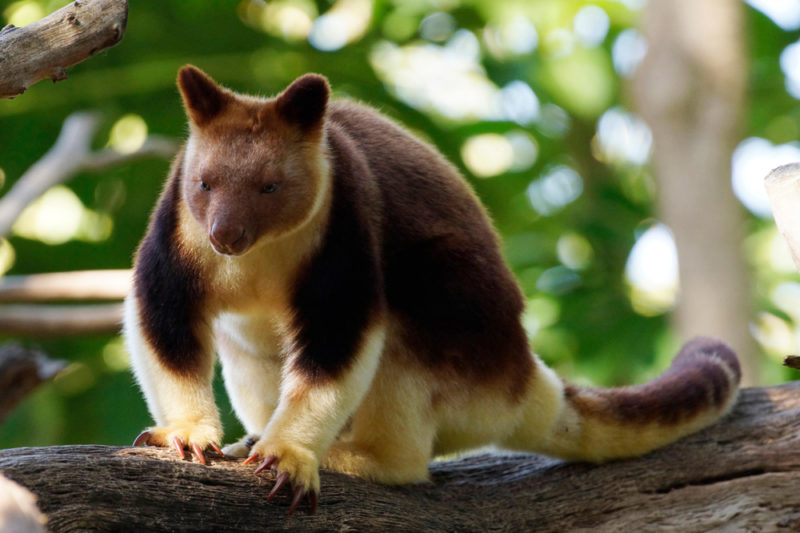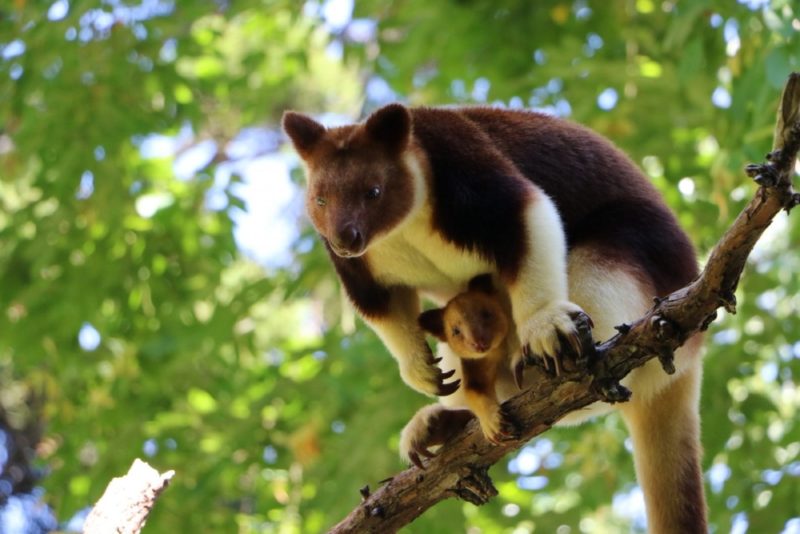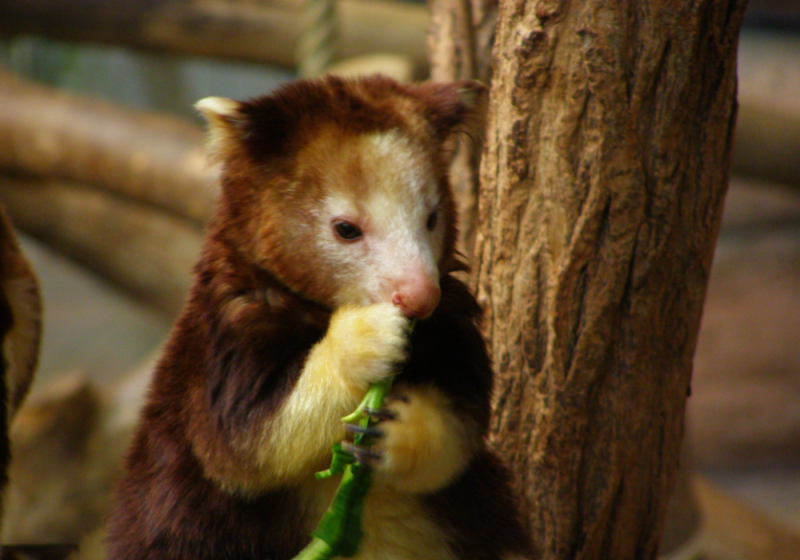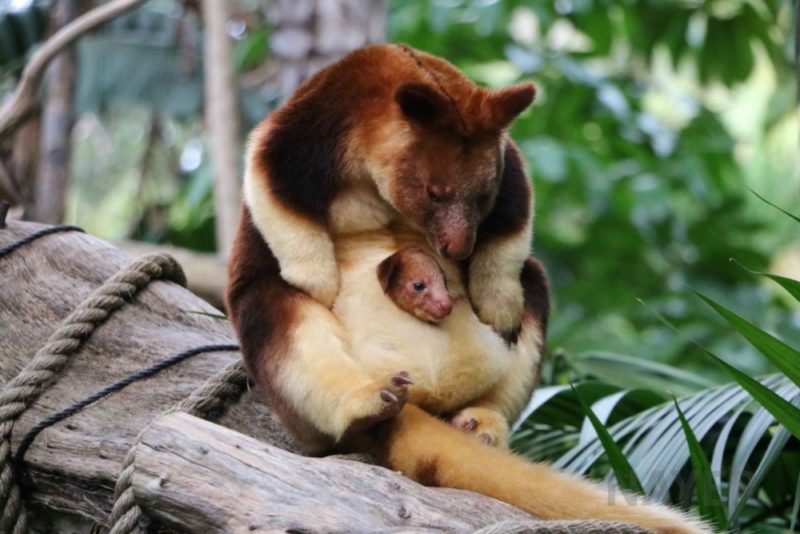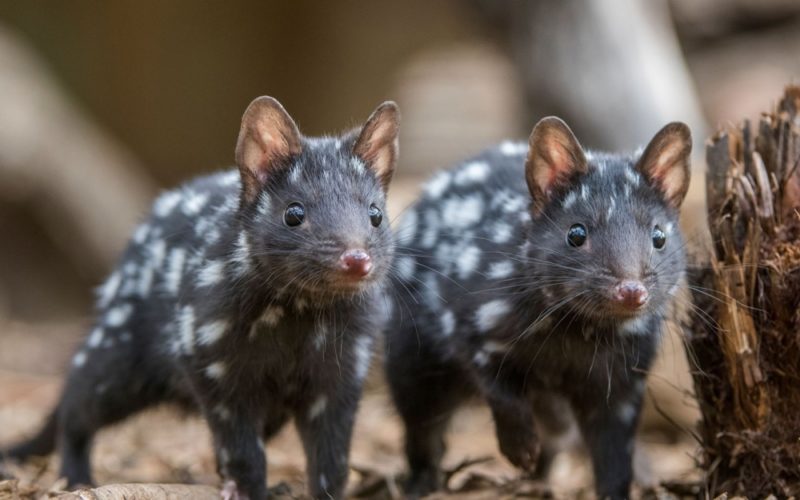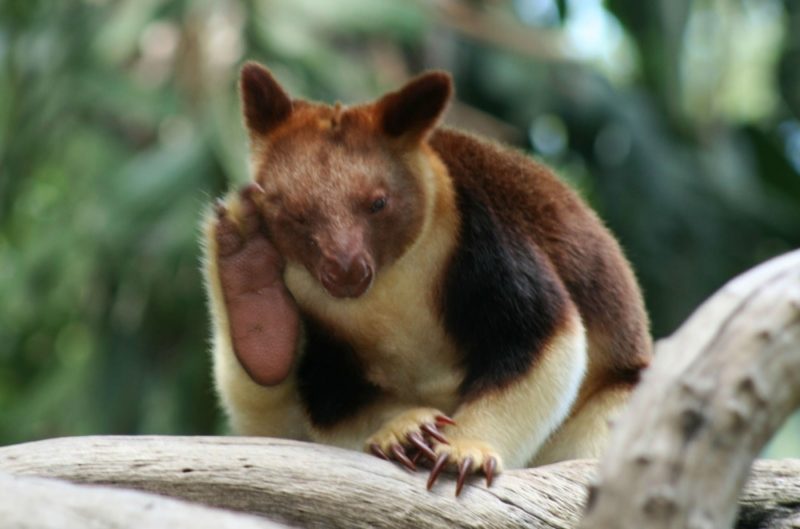The Kangaroo family is very diverse. Among its many representatives there are species that spend most of their lives in trees. They are united in the genus Woody Kangaroo (Dendrolagus). Representatives of the latter for small sizes are often called "wallabies." These cute funny creatures look like bear cubs, and in temperament are similar to sloths. There is a lot of unusual and interesting in their life.
Material Content:
Features and habitat
The birthplace of tree kangaroos is the high mountain rainforests of the island of New Guinea. Man contributed to their spread across the Australian continent, so now Wallaby lives on other nearby islands.
Unlike their relatives, leading exclusively terrestrial lifestyles, tree kangaroos are much smaller. The weight of the largest individuals does not exceed 18 kg, and the length from the crown to the tip is 1.5-2 m.
The body of the wallaby is covered with thick hair.
Species features are its length, structure and color:
- The coat can be soft and resemble plush or hard, bristly.
- In most species, the back, limbs and tail are colored in dark, black or brown shades, often with longitudinal or transverse stripes. The abdomen and base of the paws are lighter - yellow or white.
In addition to the small size, structural features and color of the wool, wood wallaby differ:
- a round head shape, a short muzzle and small rounded ears, giving the appearance of an animal similar to cubs;
- short hind legs with a wide sole, on which there are pads with hard covers, which allows animals to easily move on any surface and adopt stable postures;
- long sharp and bent claws that help the wallaby to move along the branches of trees, grab, attract and pluck leaves and fruits;
- long hairy tail, which performs the function of a rudder and balancer during running and jumping.
During movement, woody kangaroos hold their body horizontally, which also distinguishes them from ground forms that move strictly vertically.
Character and lifestyle of a wood kangaroo
Marsupial wood kangaroos make an impression of leisurely, loving to sleep and constantly chewing good-natured animals who prefer society to loneliness. Most species live in families (male, female, and calves) or in packs (several females with calves are subordinate to one male).
All members of the genus are nocturnal:
- in the afternoon, up to 15 hours in a row, sleep or bask, comfortably sitting on large branches;
- with the onset of darkness, they begin to show activity and go in search of food.
For all their leisurelyness, the wood kangaroos jump beautifully, breaking up to 9 m in length and 18-20 m down without harming themselves. Occasionally, mainly to search for water, they descend to the surface of the earth and move slowly and awkwardly, in small leaps.
Diet
Marsupial kangaroos feed on plant foods.
The basis of their diet is foliage, small branches of trees, shoots of vines, flowers, fruits and grass. They are more picky in food than their terrestrial relatives and can spend hours looking for their favorite treats - passion fruit and eucalyptus leaves. Having found the desired, animals cleverly grab the branches with their paws. Bending the fingers, tear off or nip off the leaves and send them into the mouth.
Plant food is low-calorie, so Wallabies are forced to eat a lot, for which they gained the glory of voracious animals.
Mating season and reproduction
Wood kangaroos have no pronounced mating season.
Being safe and having enough food, they breed all year round.
The process begins with courtship, during which the males make peculiar sounds resembling the cackling of hens. Choosing a girlfriend, the male tries to pat her on the head. As a sign of location, the female turns her back and allows her to stroke her tail. This is a kind of sign of consent, after which mating occurs.
After 30-40 days a small (about 2.5 cm) calf is born that resembles an embryo. On a path previously licked by a kangaroo mother, he moves into her pocket or bag. The baby is so helpless that it cannot suck on its own, therefore it is attached to the nipple, from which milk is periodically thrown into his mouth.
After 8-12 months, the baby begins to be active. At first, she simply looks out of the bag, then leaves it for a short while, but at the slightest danger returns back. It will become completely independent after 2 years. As soon as this happens, a new baby appears in the pocket. Wood kangaroos live 17-20 years.
Natural enemies
Wallabies can be attacked by foxes and cats brought to the Australian continent by humans, marsupials, marten, large birds of prey and snakes. Wood kangaroos flee from predators and only occasionally are able to fend for themselves. They suddenly stop, quickly turn to the pursuer, clasp his front limbs and mercilessly strike back.
The greatest danger to tree kangaroos is not natural enemies, but deforestation.
Wallabies are not able to migrate long distances, therefore, having lost their food, they die. The number of animals is gradually declining. Some species, such as the Goodfellow Kangaroo, are on the brink of extinction. To preserve the species, protected areas are created where they are engaged in the artificial breeding of these animals.
Interesting Kangaroo Facts
There are many interesting points in the life of the wallaby. For example, 2-3 males liked one female. The choice decides the fight.Excited males, like sumo wrestlers, mate with their front paws, using the tail as a support, and claw each other with force with their hind limbs. During such tournaments, animals are often seriously injured.
Many are unique in the behavior of females.
For example:
- Females of wood kangaroos are able to change the duration of their pregnancy. If a baby in a pocket dies for some reason, another will soon appear in its place. It turns out that the new embryo can wait, slowing down development and waiting for the release of my mother’s pocket.
- An interesting fact is that young females give birth to young females, and mature individuals give birth to males.
- Females of tree wallaby are caring and loyal mothers. They allow them to climb into the bag, where the cub is already, to his grown brother or sister, if that is in danger or wants to feel the mother's warmth. During the chase, they try to discreetly throw the baby out of the pocket and lead the pursuer away, diverting attention to themselves. If the animal manages to escape, it will certainly come back and find its cub.
The study of wood kangaroos continues. Until now, they publish new interesting facts confirming the uniqueness of this type of animal.


